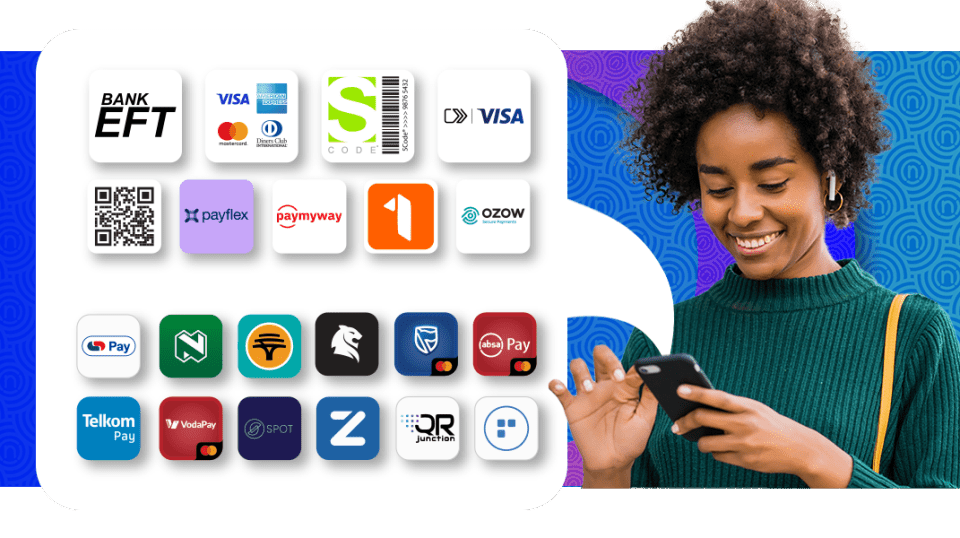
Payment fraud trends and how to protect your business
October 31, 2025
Top online payment methods in South Africa (2025 update)
November 14, 2025Online shopping in South Africa is at a tipping point. More people are turning to digital platforms to browse, compare, and buy products and services. For you as a business owner, this rapid shift is more than just a trend, but a signal of how customers expect to interact with your brand.
Understanding where the eCommerce market is heading can help you make smarter decisions. From how people prefer to pay to what makes them abandon a cart, the latest data reveals insights you can use to shape your business strategy and achieve your goals. In 2025, online spending in South Africa is expected to reach nearly R400 billion, reflecting how quickly customer behaviour is shifting toward digital-first shopping.
Let’s dive into the most important South African eCommerce statistics you should know in 2025.
Don’t just read the trends
— act on them with our secure payment gateway.
Overview of South Africa’s eCommerce Growth in 2025
Online retail in South Africa continues to accelerate, driven by rising smartphone use, improved delivery networks, and growing consumer trust in digital payments. With millions of new shoppers entering the market each year, businesses that adapt quickly will capture the biggest share of growth.
Key South Africa eCommerce stats 2025
Here are 15 eCommerce stats about online shoppers in SA that every business should know.
Tip: Selling products or services online, or thinking about it? Discover how a multiple-payment option gateway can help you expand your audience reach and accelerate online sales.
1. 11.7 million South Africans forecasted to shop online in 2025
According to the Digital Market Outlook by Statista, over 11 million South Africans will shop online. That’s a massive customer base ready for businesses like yours. The number reflects more than just population growth, but it also shows the increasing role of technology in daily life. Affordable data, smartphone adoption, and improved delivery networks are fuelling this growth.
In 2024, just over 10 million South African internet users shopped online, indicating a growing trend that is likely to continue upward. What does it mean for you? If your products or services are not available online, then you’re missing out on a share of this growing digital marketplace.
2. Fashion accounts for 32% of the eCommerce market
The Statista data referenced above also shows that fashion remains the largest online shopping category, making up 32% of South Africa’s eCommerce market. From clothing and shoes to accessories, it’s clear that style sells online. It is followed by toys, hobbies, and DIY, at 27%.
Even if you’re not in any of these industries, you can still learn something important from this trend: consumers are comfortable buying items that traditionally required in-person shopping.
Tip: Fashion shoppers are highly mobile-first, so ensure your product pages, checkout and payment options are fully optimised for smartphone users.
This means your brick-and-mortar business is not exempt from online shopping. Instead, it is actually desired by customers. If you’re not selling online yet, you’re leaving money on the table.
Ready to sell online? Find out which one is better for eCommerce, WooCommerce or Ecwid.
3. Free delivery drives 67.3% of online purchases
Another crucial factor that is a primary driving force for online shopping in South Africa is the cost of delivery. According to recent data, 67.3% of online shoppers mention free delivery as the number-one reason for completing a purchase.
For you, this means rethinking how shipping fits into your pricing model. Offering free, subsidised, or subscription-based delivery, such as TakealotMORE, could be the difference between a sale and an abandoned cart. Customers want convenience without extra costs.
Well-known South African retailers like Takealot and Checkers Sixty60 use free or flat-rate delivery promotions to increase conversions — showing how powerful transparent delivery pricing can be.
4. 53.8% of online shoppers join loyalty programmes
Every business owner knows that customer retention is just as important as acquisition. More than half of online shoppers (53.8%) actively join loyalty programmes, making them one of the most significant drivers of eCommerce in South Africa.
If you’re not offering rewards, discounts, or early access to new products, you’re likely losing out to competitors. A well-designed programme not only encourages repeat purchases but also helps you build stronger relationships with your customers.
The best part is that you don’t have to build out an entire system if you don’t have the time or resources to do so. By adopting payment options such as Zapper, you benefit from a fast and secure payment system, which is widely trusted by customers. Additionally, your customers get to use a frictionless payment option that is instant and secure, all while earning rewards.
5. 43.8% of shoppers seek coupons and discounts
South Africa’s slow economic growth and rising inflation mean price sensitivity is high among online shoppers. Nearly 44% of them look for coupons or discounts before making a purchase.
But this doesn’t mean you should race to the bottom of the price range; rather, it urges you to think more strategically. Offering limited-time promotions, bundle deals, or subscriber-only discounts can add perceived value.
Customers prefer transactions that are tit-for-tat, where both the business and they benefit from something of equal or greater value in return, which builds trust and satisfaction.
6. “Phygital” shopping is the future of retail in South Africa
The line between online and offline shopping is fading. The concept of “phygital” retail, where digital experiences blend with physical ones, is shaping the future of South African commerce.
This trend is mainly about enhancing the customer experience. Blending the tangible aspect of physical stores with the convenience of online ones. Think of features like ordering online and collecting in-store, or using virtual try-on tools before visiting a shop.
A good example in the South African context would be McDonald’s self-service kiosks. These allow customers to place orders independently, so they can take their time deciding what to eat, without holding up the line at the counter.
7. Debit cards are the most popular online payment method (58%)
Cash is still king in South Africa, but when it comes to online shopping, customers overwhelmingly prefer debit cards. These make up 58% of all online transactions, showing the importance of offering trusted, straightforward payment options.
With tight security measures such as 3D Secure and PCI DSS compliance, card payments are hard to beat when selling online. While alternative payment methods such as QR codes and digital wallets are on the rise, don’t abandon accepting cards just yet. Rather, enable systems like “one-click checkout” for returning shoppers to reduce friction during this crucial stage.
Adding digital wallets, Instant EFT and mobile-friendly payment options through the Netcash Payment Gateway will further reduce friction for South Africans who prefer fast, smartphone-based checkout.
8. 46% of South Africans trust influencer recommendations
Trust plays a big role in purchase decisions. According to KLA research, 46% of South Africans trust products recommended by influencers. This trend highlights the power of social commerce and reinforces why collaboration and influencer marketing are solid marketing strategies.
Partnering with the right voices, whether big names or micro-influencers in your niche, can build credibility and drive sales. Just make sure these influencers’ values align with those of your business, as inauthentic campaigns can lead to a loss in brand trust and customer skepticism.
9. Holiday spending increases by 7% as online shopping grows
Seasonal shopping continues to grow in South Africa, but there are some shifts. Research by IOL shows that holiday purchases grew by 7% year-on-year, largely thanks to online shopping.
The festive season, spanning between mid-December and January, is a critical time for retailers. Many businesses report this to be their busiest and most profitable time of year, so ensuring your online store is ready with promotions, reliable delivery, and smooth payments can help you capture a bigger slice of that holiday spend.
This is also a time when people are visiting family, away on holiday, or attending annual events, so agility is crucial. Be sure to enable multiple payment options for more convenience, from contactless vouchers to Buy Now, Pay Later (BNPL) solutions that offer an expense cushion.
10. Black Friday 2024 saw over R30 billion spent online
Black Friday (or more broadly “Black November”) has become one of the biggest shopping events in the country. In 2024, South Africans spent more than R30 billion over Black Friday weekend, according to Daily Maverick. And this number is set to rise in 2025.
Electronics, beauty, and fashion dominated sales, showing where consumer demand peaks. So, planning well in advance for Black Friday can be one of the most profitable moves of the year.
Want to get in on the action? Here’s a guide to optimise your store for the Black Friday rush.
11. Cart abandonment rates reach 75% in South Africa
One of the biggest challenges in eCommerce is cart abandonment. In South Africa, the rate sits at a worrying 75%, but this may be as high as 83.5%, according to a report by ECDB.
This means three out of four shoppers who add something to their basket don’t complete the purchase. Causes include unexpected delivery fees, complicated checkouts, and a lack of payment options. Optimising your checkout journey is critical to recovering lost sales.
How to Reduce Cart Abandonment in South Africa
- Display total costs (including delivery) upfront.
- Offer guest checkout to speed up the process.
- Provide multiple trusted payment options.
- Show trust badges and security indicators at checkout.
12. Third-party marketplaces power a large share of eCommerce sales
Marketplaces remain a major force in online shopping. Platforms that pool together multiple vendors account for a significant share of South Africa’s eCommerce activity.
For smaller businesses, this offers both opportunities and challenges. Marketplaces can give you exposure and sales volume, but they also mean competing directly with other brands on the same platform. Use detailed product descriptions, images, and reviews to make your products stand out. Also, look at the marketplace’s analytics tools and indicators for better targeting.
13. 90.1% of shoppers avoid retailers with poor reviews
Reputation matters in the online shopping landscape. According to eCommerce.co.za, over 90% of South Africans avoid retailers with negative reviews or low ratings.
This shows the importance of excellent customer service and reputation management. Reviews are not just there to make your brand look good online; they are trust signals that customers take into consideration before making a purchase.
Encouraging happy customers to leave reviews and addressing complaints quickly can make or break your online credibility. Positive Google reviews also increase your visibility in local search results, making it easier for customers to find and trust your online store.
14. BNPL market in South Africa expected to grow by 13.6%
The Buy Now, Pay Later (BNPL) sector is gaining traction. A Fintech Futures report projects that the South African BNPL market is expected to grow by 13.6%, hitting trillions of rands in 2025.
This rise is an indicator of the market. Customers who cannot afford to make big purchases at once, or who are looking to balance their budgets more effectively, are choosing this as an option.
For your business, offering BNPL could also attract a younger, budget-conscious audience, who may not have a lot of money to spend just yet, but can afford to pay in instalments.
15. Online sales projected to hit R400 billion by 2025
Perhaps the most striking figure is that South African online sales are expected to reach R400 billion in 2025. This highlights the scale of the opportunity. Whether you’re a retailer, service provider, or supplier, the digital economy is becoming a cornerstone of consumer spending.

Mobile vs desktop trends for shopping online
Here is a comparison of mobile vs desktop shopping in South Africa based on the latest available data in 2025:
|
Aspect |
Mobile |
Desktop |
|
Percentage of online purchases |
51.7% of all online purchases are made via smartphones |
Remaining purchases made via desktops, tablets, laptops |
|
Internet users owning a device |
99.3% of internet users own smartphones |
79.1% own laptops, MacBooks, or PCs |
|
Market share (web traffic) |
About 72.7% mobile market share (Dec 2024) |
About 27.3% desktop market share |
|
Growth trend |
Increasing preference due to smartphone penetration and mobile-first marketing |
Lower growth compared to mobile |
|
User behaviour |
Mobile shopping grows with more smartphone users and integrated apps for payments |
Still significant for certain purchase types and desktop loyalists |
|
eCommerce growth |
Mobile commerce (m-commerce) is a key driver, with over 8 billion transactions expected in 2025 |
Desktop is still important, but less dominant compared to mobile |
|
Average order value (AOV) |
Slightly rising on mobile phones, showing growing trust in mobile shopping |
Higher average order values are sometimes seen on desktop |
Emerging Payment Technologies in South Africa
New payment methods such as PayShap, QR-based payments and Buy Now, Pay Later (BNPL) solutions are accelerating eCommerce growth. These options give customers more flexibility and reduce friction at checkout, especially for mobile-first shoppers.
South African payment trends and preferences
Here are some insights to keep in mind about payment trends in South Africa:
- Debit cards remain the most popular option, used by 58% of online shoppers.
- Instant EFT and digital wallets are on the rise, giving customers more flexibility.
- BNPL is expanding, appealing to younger consumers who want short-term credit.
- Security and trust drive behaviour; customers favour payment methods they know and perceive as safe.
Implications for your business
Here’s what all these trends and stats mean for your business:
- Focus on mobile-first design to capture the majority of shoppers.
- Offer free, subsidised, or subscription-based delivery to reduce cart abandonment.
- Build loyalty programmes and discount strategies to drive repeat business.
- Consider adding BNPL and digital wallets to your payment options.
- Manage your online reputation proactively; reviews carry heavy weight.
- Leverage seasonal events like Black Friday to maximise sales.
Don't know where to start when choosing the right payment methods for your business?
Speak to our Payments Advisors, we'll know what to do.
Frequently Asked Questions
Wrapping up stats that online shoppers in SA should know
The South African eCommerce market is expanding quickly, with billions in sales and millions of new shoppers entering the space. For your business, the data highlights clear priorities: focus on mobile, invest in delivery, build loyalty, and ensure secure, trusted payments.
The opportunity is there. You just need the right strategy to capture it.
Speak to a Payments Advisor today and see how we can help you with your online venture.

With a wealth of experience and a strategic vision that transcends boundaries, Liana Clarke is the architect of our marketing success story. Their leadership style is a perfect blend of inspiration and strategic acumen, guiding our team through the ever-changing landscape of consumer preferences and market trends.



